Weaving a rounded six-plait cord
31 May 2010Click here to visit an upgraded version of this blog post on my new website at alibrown.nz.
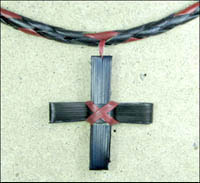 If you’ve mastered the rounded four-plait cord you may like to try plaiting a rounded cord with six strips. Plaited cords look good as a necklet or bracelet or they can be made into an original piece of jewellery with the addition of a pendant. I made the flax pendant illustrated here by adapting a pattern for an Easter palm cross.
If you’ve mastered the rounded four-plait cord you may like to try plaiting a rounded cord with six strips. Plaited cords look good as a necklet or bracelet or they can be made into an original piece of jewellery with the addition of a pendant. I made the flax pendant illustrated here by adapting a pattern for an Easter palm cross.
 Using six strips opens up more possibilities for different patterns on the cord. The patterning on the cord will depend on which order the colours are hung together at the start and how many strips are used for each colour. The three patterns illustrated here are made as follows: the first sample is made using two green and one white strip on each side, (the white strips were the two strips in the middle), the second sample uses alternate green and white strips and the third one uses five green and one white strip. The same effect will be achieved no matter where the one different-coloured strip is put in the sequence in this pattern.
Using six strips opens up more possibilities for different patterns on the cord. The patterning on the cord will depend on which order the colours are hung together at the start and how many strips are used for each colour. The three patterns illustrated here are made as follows: the first sample is made using two green and one white strip on each side, (the white strips were the two strips in the middle), the second sample uses alternate green and white strips and the third one uses five green and one white strip. The same effect will be achieved no matter where the one different-coloured strip is put in the sequence in this pattern.
 For the sample illustrations, I’ve used six different coloured flax strips to clearly show the plaiting of a rounded six-plait cord. The colours from left to right are pink, blue-green, white, lime-green, yellow and striped. A six-plait cord made from strips becomes rounded because the shiny side of each strip is kept to the outside of the cord all the time as you plait. Start with six flax strips all the same width.
For the sample illustrations, I’ve used six different coloured flax strips to clearly show the plaiting of a rounded six-plait cord. The colours from left to right are pink, blue-green, white, lime-green, yellow and striped. A six-plait cord made from strips becomes rounded because the shiny side of each strip is kept to the outside of the cord all the time as you plait. Start with six flax strips all the same width.
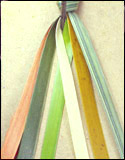 As for any cord, it’s easier to get an even plait if you have one end of the work held by a friend or you tie the end around a solid object such as a chair leg or a nail in a piece of wood. This means you can pull the strands towards you as you plait, so you can keep an even tension on the plaiting. Here I’ve used a nail banged into a piece of wood. Arrange the strips so that the shiny side of each strip is showing uppermost. Start by crossing the left middle white strip over the right middle lime-green strip.
As for any cord, it’s easier to get an even plait if you have one end of the work held by a friend or you tie the end around a solid object such as a chair leg or a nail in a piece of wood. This means you can pull the strands towards you as you plait, so you can keep an even tension on the plaiting. Here I’ve used a nail banged into a piece of wood. Arrange the strips so that the shiny side of each strip is showing uppermost. Start by crossing the left middle white strip over the right middle lime-green strip.
 Now pick up the right-hand outside strip, the striped one, and keeping the shiny side of the flax showing, take it across to the left, under the yellow strip that’s next to it, and over the next white strip.
Now pick up the right-hand outside strip, the striped one, and keeping the shiny side of the flax showing, take it across to the left, under the yellow strip that’s next to it, and over the next white strip.
 Go to the left-hand side, and keeping the shiny side of the flax showing, take the outside red strip to the right over the blue-green strip next to it, under the lime-green strip and then over the striped strip. This completes the starting sequence.
Go to the left-hand side, and keeping the shiny side of the flax showing, take the outside red strip to the right over the blue-green strip next to it, under the lime-green strip and then over the striped strip. This completes the starting sequence.
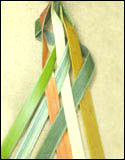 The next sequence of movements are the ones that are repeated to make the six-plait cord. Go to the left-hand side and take the blue-green strip back behind all the other strips, and then bring it around and to the front, keeping the shiny side on the outside all the time. Now take the blue-green strip over the yellow one, under the white one, and over the red one.
The next sequence of movements are the ones that are repeated to make the six-plait cord. Go to the left-hand side and take the blue-green strip back behind all the other strips, and then bring it around and to the front, keeping the shiny side on the outside all the time. Now take the blue-green strip over the yellow one, under the white one, and over the red one.
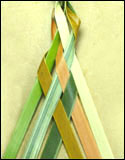
Go to the right side and, keeping the shiny side on the outside, take the yellow strip behind all the others, and then bring it around to the front. Now take it over the lime-green one, under the striped one and over the blue-green strip.
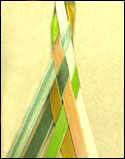
Go to the left side and, keeping the shiny side to the outside, take the lime-green strip around the back and bring to around to the front. Now take it over the white strip, under the red strip, and over the yellow strip.

Go to the right side and, keeping the shiny side to the top, take the white strip behind all the others and bring it around to the front. Then take it over the striped one, under the blue-green one and then over the lime-green strip. Repeat this sequence, remembering to alternate the sides that you pick up the strip to plait with. A way to make sure that you are choosing the right strip to start each plait with is to compare the outermost strips on each side. The strip that emerges from the side of the plait at the lowest point is the one to use. For example, in this photo here, it is the striped one on the left which is the one to plait with as it’s lower than the red one on the right.

As you plait, pull the strips up tightly together so that the cord becomes rounded and tightly plaited. I made this cord with six differently-coloured strips to make it easier to follow the instructions, but, as the photos at the top of this post show, it’s fun to use this plait to make differently patterned cords.
I found the instructions for the six-plait rounded cord in a leatherwork book written by Ron Edwards, the founder of the Australian Whipmakers and Plaiters Association. Ron wrote many books on leatherwork and some of the ideas and techniques are useable in flax weaving. You can find his books for sale at Rams Skull Press.
© Alison Marion Brown 2010.


July 5th, 2010 at 4:28 pm
Great! Thanks for putting up the instructions for the 6 plaid cord. The colour coding makes it extra easy to follow. Keep up the good work!
September 21st, 2010 at 8:24 pm
Hi Ali, Do you have any idea on how to weave a placemat??? Plz help!
September 28th, 2010 at 9:28 am
It depends on what sort of placemat you want. If you’re happy with a simple placemat, I’d suggest you just weave a square and then twine around the edges to hold the weaving in place, and trim the ends to size. You could also fold the end strips back and weave them into the placemat, but if you do this it can be difficult to make the placemat sit flatly on the table.
October 6th, 2010 at 10:31 am
Thanks so much ALI I tried that and it worked!
See ya FLINT
October 27th, 2010 at 1:42 pm
Hi Ali
Do you have a weaving pattern of how to do a waikawa basket. I know it is made from the whole flax leaf and bent back in half from the mid rib but thats about it. Would appreciate some help. Cant get to any weaving classes.
October 27th, 2010 at 6:18 pm
Hi Jan
I don’t currently have written and photographed instructions for the waikawa but it will probably be part of the kete weaving book that I am currently working on.
December 6th, 2010 at 10:32 am
Wow!! I am so pleased I found your site. I have done a few kete but I seem to work backwards to the maori style, I call my style the celtic way, as my ancestors of old wove flax. I would love to do another flower to go with my Christmas wrappings but have forgotten how they are done.
Thanks for your instructions.
April 13th, 2011 at 10:01 am
kia ora ali
want to know how to weave a waikawa i know how to weave a kona 4 corner .please help
cheers
April 16th, 2011 at 5:50 pm
Kia ora Tradine
I don’t have written instructions for a waikawa as yet but it will be one of the baskets that I will have instructions for in the new book I am writing on basket-making. The book will be a while away yet but keep an eye on my blog for updates on when it will be published.
June 8th, 2012 at 2:57 pm
kia ora Ali
i would like to know how to complete my piu piu, im a self taught weaver but i wasn’t shown how to do the 6plait finish if you can much appreciated
June 10th, 2012 at 5:10 pm
Kia ora Shirley
On page 61 of the book “How to make a piupiu” by Leilani Rickard, there are instructions on how to do the braid at the top of a piupiu. It is a taniko braid which is the usual way to finish a piupiu rather than plaiting. You should be able to get the book from your local library.